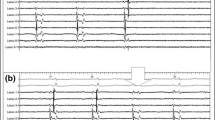Abstract
Purpose
Circumferential pulmonary vein (PV) isolation has been widely accepted for catheter ablation in patients with atrial fibrillation (AF). Dissociated PV activity might appear after PV isolation (PVI). However, little is known of dissociated PV activity. This study aimed to reveal the electrophysiological properties and clinical implications of dissociated PV activity.
Methods
The study subjects were 52 patients (62 ± 7 years, 38 men) who underwent PVI for AF. Electrophysiological properties of the left atrium (LA) and PVs during and after PVI were investigated.
Results
Out of 181 targeted PVs, 177 with successful isolation were analyzed. Dissociated PV activity appeared in 14 PVs (8 %) in 12 patients (23 %) after PVI; from the left superior PV in eight, right superior PV in five, and left inferior PV in one. The mean cycle length of dissociated PV activity was 4277 ± 2565 ms. The presence of AF prior to achieving PVI was significantly higher in PV without dissociated PV activity (105 out of 163, 64 %) than in PV with dissociated PV activity (five out of 14, 36 %, P = 0.03). The observed dissociated PV activity was enhanced (new appearance or reduced cycle length) by isoproterenol and suppressed by pacing within the isolated PV.
Conclusion
Dissociated PV activity, although influenced by uncertain factors such as overdrive suppression and autonomic situations, would be an indicator of LA-PV bidirectional block and might not be the target of additional ablation after PVI.



Similar content being viewed by others
References
Haïssaguerre M, Jaïs P, Shah DC, Takahashi A, Hocini M, Quiniou G, et al. Spontaneous initiation of atrial fibrillation by ectopic beats originating in the pulmonary veins. N Engl J Med. 1998;339:659–66.
Calkins H, Reynolds MR, Spector P, Sondhi M, Xu Y, Martin A, et al. Treatment of atrial fibrillation with antiarrhythmic drugs or radiofrequency ablation: two systematic literature reviews and meta-analyses. Circ Arrhythm Electrophysiol. 2009;2:349–61.
Miyazaki S, Kuwahara T, Kobori A, Takahashi Y, Takei A, Sato A, et al. Prevalence, electrophysiological properties, and clinical implications of dissociated pulmonary vein activity following pulmonary vein antrum isolation. Am J Cardiol. 2011;108:1147–54.
Doi A, Satomi K, Makimoto H, Yokoyama T, Yamada Y, Okamura H, et al. Efficacy of additional radiofrequency applications for spontaneous dissociated pulmonary vein activity after pulmonary vein isolation in patients with paroxysmal atrial fibrillation. J Cardiovasc Electrophysiol. 2013;24:894–901.
Willems S, Weiss C, Risius T, Rostock T, Hoffmann M, Ventura R, et al. Dissociated activity and pulmonary vein fibrillation following functional disconnection: Impact for the arrhythmogenesis of focal atrial fibrillation. Pacing Clin Electrophysiol. 2003;26:1363–70.
Dixit S, Gerstenfeld EP, Callans DJ, Marchlinski FE. Mechanisms underlying sustained firing from pulmonary veins: evidence from pacing maneuvers and pharmacological manipulation. Pacing Clin Electrophysiol. 2004;27:1120–9.
Weerasooriya R, Jaïs P, Scavée C, Macle L, Shah DC, Arentz T, et al. Dissociated pulmonary vein arrhythmia: incidence and characteristics. J Cardiovasc Electrophysiol. 2003;14:1173–9.
Valles E, Fan R, Roux JF, Liu CF, Harding JD, Dhruvakumar S, et al. Localization of atrial fibrillation triggers in patients undergoing pulmonary vein isolation: importance of the carina region. J Am Coll Cardiol. 2008;52:1413–20.
Takigawa M, Yamada T, Yoshida Y, Ishikawa K, Aoyama Y, Yamamoto T, et al. Patterns of pulmonary vein potential disappearance during encircling ipsilateral pulmonary vein isolation can predict recurrence of atrial fibrillation. Circ J. 2014;78:601–9.
Author information
Authors and Affiliations
Corresponding author
Ethics declarations
Sources of support
None.
Conflict of interest
The authors declare that they have no conflict of interest.
Rights and permissions
About this article
Cite this article
Kaneshiro, T., Suzuki, H., Nodera, M. et al. Fibrillatory excitation in the pulmonary vein is associated with the presence of dissociated pulmonary vein activity after isolation. J Interv Card Electrophysiol 47, 231–236 (2016). https://doi.org/10.1007/s10840-016-0154-1
Received:
Accepted:
Published:
Issue Date:
DOI: https://doi.org/10.1007/s10840-016-0154-1




